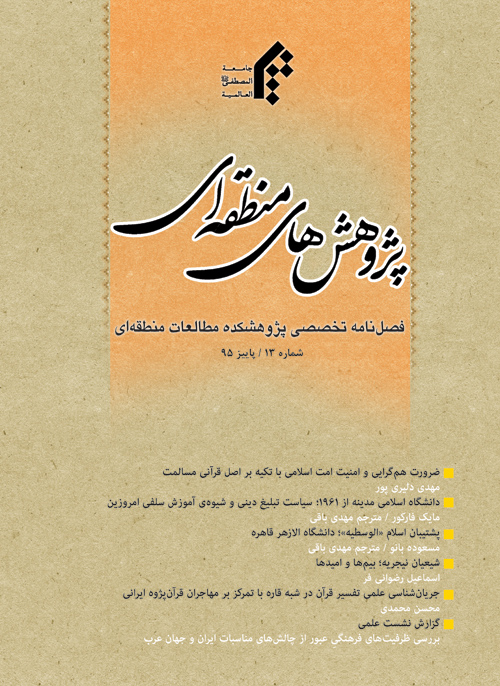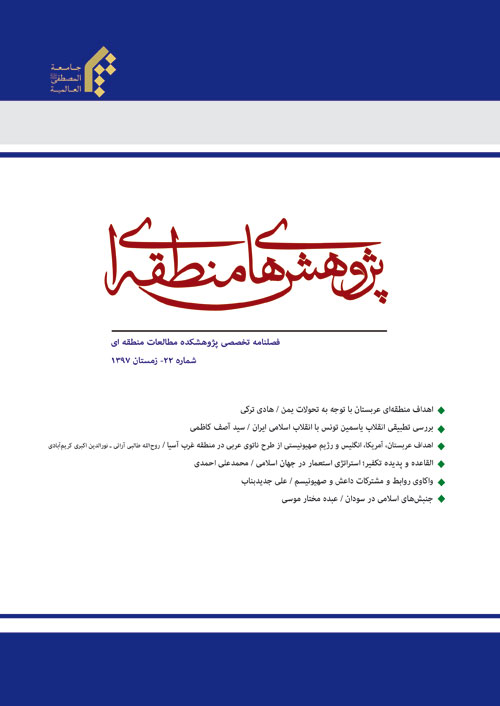فهرست مطالب

فصلنامه پژوهش های منطقه ای
سال چهارم شماره 13 (پاییز 1395)
- بهای روی جلد: 30,000ريال
- تاریخ انتشار: 1395/09/20
- تعداد عناوین: 7
-
صفحه 9
-
صفحه 120
-
Page 16Islam has advanced and improvement teachings issued by God, as the Creator of the World, for the development and sublimity of human being. In Islamic teachings, peace, tranquility and avoidance of distrust in society are very important. According to Islamic teachings and principles, it can be well understood that peace and brotherhood are at the top of the social affairs of the Islamic community. As a result, it should be avoided, as much as possible from internal conflict. This principle is one of the preconditions and assumptions of Islam; because the abuse of enemies from the differences, in creating the fire of sectarian strife and destruction of Islam, is definite. Permission of war and killing is given only in cases where there are no solutions to some people and deviant sects. What we are trying to answer in this article is that, according to the Quranic principle of peace, in verse 208 of Surah al-Baqarah, and based on Islamic beliefs, how much does the Islamic unity impact on the realization of world peace? and does Islam show the ability to establish lasting peace in the world? If yes, what are the requirements and challenges? This paper uses a descriptive-analytical method and uses library resources to explain the relevance of these titles.Keywords: Holy Quran, Peace, Unity, Convergence, Takfiris
-
Page 53The Islamic University of Madinah is one of the most prominent universities supported by the Saudi government, since its establishment, it has been operating in a global context, and has been able to attract students from different parts of the world. The present paper, given the dearth of research on the history of this influential university, intends to address the important aspects of the genesis and evolution of this university over half a century and expansion of its activities in different parts of the world. The author, while reviewing the institutional framework, tries to look at the educational literature of this university.Keywords: Saudi Arabia, Medina University, Promotion Policy, Education, Salafism
-
Page 89The al-Azhar mosque was founded in the 10th century by the Shiite Ismaili Fatimid caliphate, and based on its endowments, the teaching positions were set up; its endowment, shortly afterwards, with a number of teaching positions marked the birth of the center of Islamic learning that was to become al-Azhar University. This mixed origin, along with a range of other factors such as Egypts strong tradition of cultural pluralism; the geopolitical developments that led to Cairo becoming the geographical center for convergence of Muslim scholars, as well as twentieth century stateled reforms of al-Azhar in the twentieth century have all played important roles in the rise of al-Azhars al-Wasatiyya Islam. This article examines how the pursuit of al-Wasatiyya Islam has been important in shaping al-Azhar to stay steadfast in this pursuit and the article tries to talk about the reasons for al-Azhar's steadfastness and solidarity in this regard.Keywords: Egypt, al-Azhar University, Islam al-Wasatiyya, the Islamic Wor
-
Page 120The name of Shiism in Nigeria was first introduced after the victory of the Islamic Revolution. When a small group of young Muslims in scientific centers responded to this emerging phenomenon by following news and events related to the Islamic Revolution and were influenced by the fact that Islam is capable of making radical changes in all social, political and economic spheres. This led to their public confirmation and public support for the Islamic Revolution of Iran and its leadership. The group attempted to establish a revolutionary movement that was in the wake of the revolution against the ruling system and the establishment of an Islamic state. In Nigeria, this approach has led to clashes between them and the security forces, and the result was that leaders of the movement were imprisoned many times. Throughout these years Nigerian Shiites have been challenged by two groups: A group of extremist Christians and Muslims, and the Nigerian army and security agencies.
This paper seeks to investigate the situation of the Nigerian Shiite community by using a descriptive-analytical study method and exploiting library and Internet resources and seeks to answer the question of what threats and opportunities the Shiite minority faces in this country.Keywords: Shiites, Nigeria, Islamic Revolution, Opportunities, Threats -
Page 158One of the most important issues in the cultural history of the subcontinent is the migration of Iranian thinkers which has covered many scientific and cultural blessings. Especially Iranian commentators were influential in the scientific development of the interpretation of the subcontinent. In general, interpretative steps in the subcontinent can be analyzed in three parts: 1.Genesis stage (1-6th Century AH) in which the interpretation of the Quran is presented in the form of translation, then Hadith texts and mystical texts, and independent sources do not devote to the interpretation of the Quran. 2. The stage of development of commentary (7-12 century AH), in which the interpretive books are separated from the narrative resources. 3. The modernization stage, which begins after the Gurkanians and with the start of the British colonial era.
The presence of Iranian commentators was a great deal in the second phase of the interpretation of the subcontinent; Leadership in the political system, government positions, religious propaganda, social reform, strengthening relations between people and rulers were the most important political-social effects of this presence. Iranian commentators in the subcontinent were also effective in the scientific-cultural sections; among them are the growth of scientific figures, the establishment of scientific centers, and the publication of scientific works and the strengthening of the Persian language.Keywords: Interpretation, Immigration, Persian Language, Mir Sayyid Ali, Qazi Noorullah Shustari, India


